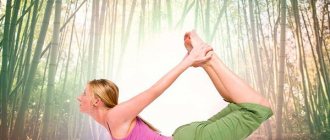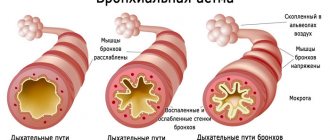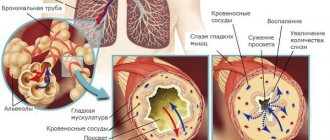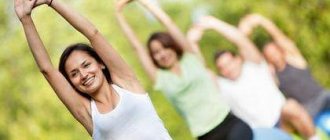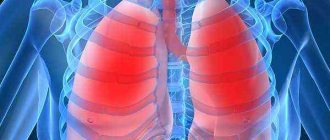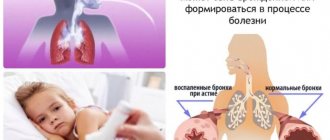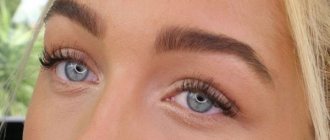Massage for bronchial asthma is one of the most effective methods of prevention in patients with bronchopulmonary diseases, preventing relapses and pre-asthmatic conditions.
It is impossible to completely cure asthma, but with the help of massage therapy (if there are no contraindications for it), the likelihood of improving the patient’s general condition and preventing complications significantly increases. Therapeutic massage helps to activate respiratory activity, increasing blood circulation and saturating tissues and organs with oxygen.
The effect of massage on the body

Massage to alleviate the condition of an asthmatic can be performed during periods of remission and during an attack. With the help of a simple procedure, you can achieve a positive effect, which, in parallel with medications, greatly improves the patient’s well-being. Massage has the following effects on the body:
- normalizes breathing;
- reduces the frequency of asthma attacks;
- thins mucus and promotes its removal;
- relaxes the respiratory muscles;
- prevents the development of pulmonary emphysema;
- has a beneficial effect on the nervous system;
- strengthens the body.
During the massage, skin receptors are irritated, which transmit impulses to the brain, thus affecting the entire body as a whole. Not only the blood supply to all organs, especially the lungs, improves, but also all metabolic processes.
During the massage, the tone of the muscles that are involved in the breathing process increases. It has a calming effect on the nervous system, and this is very important for self-control during an attack.
Additional impact techniques
Therapeutic massage for asthma can only be performed by a trained massage therapist. Everyone can use additional methods to help with asthma attacks on their own.
Acupressure
Asthma attacks can be relieved by massaging specific points in different parts of the body. They are pressed on or, applying slight pressure, rubbed. For pulmonary diseases, the effect is applied to the points of the wrist (a centimeter below the base of the thumb), the greater tubercle of the palm (at the base of the thumb), the chest (three centimeters below the collarbone), the back (between the shoulder blades), between the sternum and the collarbone.
Point exposure should not last more than five minutes. Before starting acupressure, you must consult a doctor and understand the location of the dots.
Self-massage
If you cannot resort to the help of a professional, you can do a massage for asthma yourself, but only in the absence of attacks. You will definitely need to see a specialist so that he can “prescribe” a personal course of self-massage.
First, the back, neck and chest are stroked, then they are rubbed and kneaded, and finally the vibration technique is used. Stroking is performed arbitrarily. Rubbing is more intense. After doing several kneadings, intermittent and continuous vibrations are performed. They tone the respiratory organs, so it is better to do them in the morning. At the end of the self-massage, shaking is performed.
Cupping method
With this technique, skin receptors are affected by a vacuum. Glass jars were replaced by rubber ones - safer. They do not require the use of fire and allow you to control the force of pressure.
Before using the cups, apply oil to the skin and warm it with your hands. Two cans are placed in the lumbar area and carefully “rolled” along the back. Making movements in a spiral, the cans are moved along the spinal column to the shoulder blades and again to the lower back. Then the actions are performed by each can separately. The procedure should not be lengthy. The massage course lasts 12-14 days.
Source: neAstmatik.ru
In what cases is massage contraindicated?
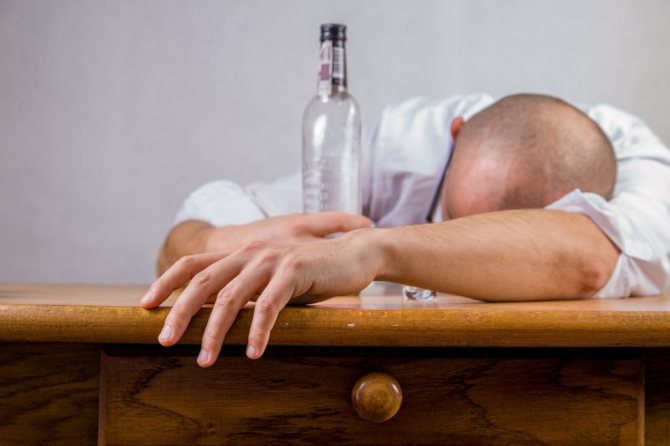
Any medical procedure has a number of contraindications, this also applies to massage. It cannot be carried out in the following cases:
- If the patient has dermatological diseases or skin lesions.
- In the presence of inflammatory processes in the body or chronic infections.
- During bleeding of any nature (massage will increase bleeding).
- With hypertension or at the time of increased blood pressure.
- During periods of exacerbation of any chronic disease (this also applies to bronchial asthma).
- For pain of any etiology, especially heart pain.
- In the presence of renal, liver and heart failure.
- While intoxicated.
- If the patient has neoplasms, even if they are benign.
- For blood diseases.
- In the presence of bronchiectasis (purulent inflammation of the lungs, accompanied by irreversible deformation of the bronchi).
- If a person is prone to thrombophlebitis or thrombosis.
- For vascular pathologies (varicose veins, aneurysm, atherosclerosis).
- If the patient has severe mental disorders.
- During pregnancy.
- During an attack.
- In case of chest injury.
If the patient feels unwell during the procedure, the massage must be stopped and the cause must be found out. Under no circumstances should contraindications be taken lightly. The massage is carried out in a course, every day, it is better to do it before lunch for 15 minutes for 15-18 days.
Important nuances
- During a massage session, a baby or young child must be placed on his knees; older children are placed on a chair.
- The duration of the first massage treatments is a maximum of 15 minutes.
- We must not forget that young patients have fragile bones. It is important to calculate the strength in advance.
- If the child resists during the asthma massage, then it is worth suspending or rescheduling the procedure.
- The doctor recommends performing some massage techniques yourself at home, subject to individual instructions.
- Parents of sick children can learn how to perform medical procedures at home. For the purpose of prevention, it is enough to do a massage several times a month.
Massage for bronchial asthma in children

Massage for bronchial asthma in children under 12 years of age is carried out by sitting the child on the lap of an adult. At the same time, it is important not to scare the baby, otherwise there will be no effect from the procedure; an overexcited nervous system will not allow achieving a therapeutic effect. To treat a child, acupressure and therapeutic rubbing are used.
These methods make it possible to strengthen the body's protective functions, expand the bronchi and reduce lung capacity. When massaging, it is necessary to remember about the child’s fragile bones.
Types of chest massage for bronchial asthma
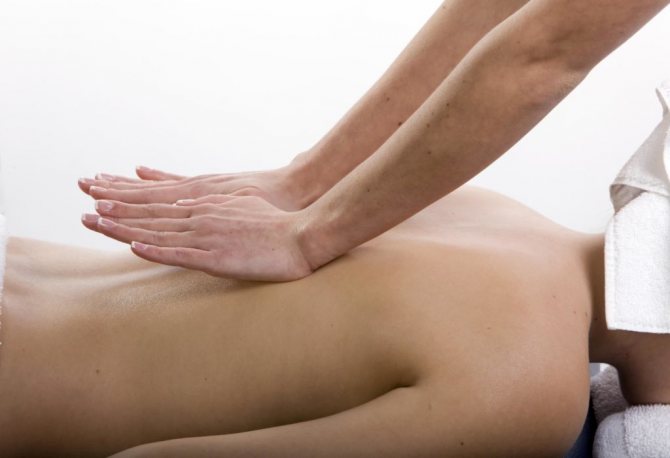
There are several types of massage that are used to treat bronchial asthma:
- Classic – used to increase overall muscle tone, improve blood circulation and ventilation of the lungs.
- Segmental - recommended in the intervals between attacks, performed asymmetrically.
- Intensive – alternate massage of a certain area, used more often in cases where other types of massage are contraindicated.
- Percussion – promotes the removal of phlegm, improves the quality of breathing, carried out using the tapping method.
- Periosteal – performed to improve lung function.
- Acupressure is the only technique that can be used during an asthma attack.
Classical
This type of massage is performed traditionally:
- massage the front chest area;
- perform a neck massage;
- move to the back area, stroke and knead;
- return to the chest area;
- Finish with a breathing massage.
The session should take place in a calm environment and help the patient relax. The specialist’s hands must be warm. The massage therapist's hands should move only in the direction from bottom to top to stimulate the outflow of lymph. If creams or oils are used during a massage for asthma, they should not have a strong odor to avoid an attack.
The main massage session is carried out in a lying position on your back or stomach, depending on the area being worked, and the breathing session is performed while sitting or standing. The session usually lasts no more than 20 minutes.
Segmental
It is aimed at reflex zones of the skin associated with the functioning of internal organs to eliminate pain and improve the health of the body. It is carried out in a sitting or standing position, the back should be straight. Before the session, the doctor must determine the segments that will be affected.
The procedure is carried out along an ascending guide from the lower sections of the segments upward. If a massage therapist performs competent segmental effects, the massage has an amazing effect and alleviates the patient’s condition.
Intensive
This technique is rarely used; they begin massaging the chest from below, then knead the upper part one by one. The procedure is performed first from the front, then from the back. Used if other types of massage are contraindicated for some reason.
Percussion
Percussion chest massage for asthma is performed to cleanse the bronchi of mucus. The masseur taps his fist on the back of the pressed palm in the area of the shoulder blades. As a result of a correctly performed procedure, the drainage of the respiratory tract improves, sputum is removed and asthmatic attacks are reduced.
Periosteal
This type of massage affects bone segments that are reflexively connected with the respiratory organs. The patient first lies on his back, then turns over on his stomach; if the doctor’s actions cause pain, the intensity of the procedure or the position of the fingers changes.
Spot
This ancient technique comes from ancient China; the doctor uses pressure and rubbing to influence internal organs through certain points on the body. Acupressure for bronchial asthma can be performed at the time of an attack to alleviate the patient’s condition.
Knowing certain points allows you to stop an attack of suffocation, relieve spasms and make breathing easier. The effect on points associated with the bronchi lasts only 5 minutes, but even this time is enough to improve the patient’s well-being. Massage during an attack of bronchial asthma should be carried out by a professional who knows the technique.
Acupressure for asthma is used on the hands and feet; it is convenient because the patient can do it himself. The doctor's prescriptions for drug therapy must be carried out in full; massage is an additional treatment and is used as part of complex therapy.
Is a consultation with a doctor required?
Before you start doing massage if you have allergic, infectious, occupational, aspirin or other bronchial asthma, you should consult with a competent doctor. It is better if it is the doctor from whom the patient is being treated. The attending physician will select the most effective type of masking. He will take into account the main diagnosis, the presence of other pathologies and other physiological characteristics of the person.
The doctor will also determine which areas of the body should be affected, how many sessions are required and how often they should be carried out. In the case of mild cases, 5-6 procedures are sufficient; for severe cases, at least 20 procedures are sufficient. Upon completion of the course, it is necessary to record the effect and adjust subsequent treatment accordingly.
Share this material on social networks. This will allow other people to learn about the benefits of massage for asthma.
Bronchial asthma, unfortunately, is considered a disease that cannot be completely cured. However, this is not a sentence that is impossible to cope with. Modern treatment methods help to quickly and effectively stop asthma attacks and improve the general condition of the patient. During treatment, massage is also often used, which is a general strengthening remedy for the prevention and improvement of the patient’s condition.
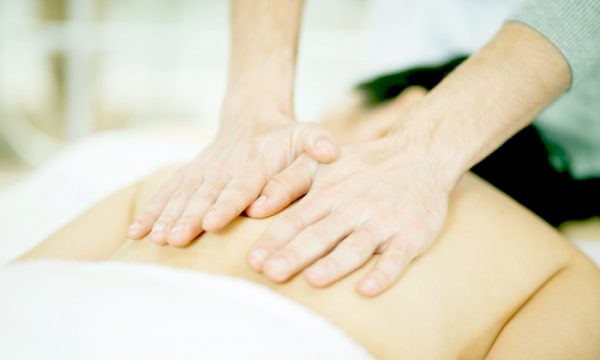
Massage effects complement the therapy system, which includes treatment with medications, beneficial herbs, special procedures and exercises. Thanks to massage, asthmatic attacks can be significantly alleviated and the number of their manifestations can be reduced, since this treatment method leads to the normalization of respiratory processes.
Massage for children
In order not to scare the child, before the massage you can play with him or offer him a massage as a game; some children are afraid of the procedure and need time to get used to it. For infants, massage is carried out according to a slightly different scheme:
- begin the massage with a gentle impact on the nasolabial triangle, smoothly moving along the cheeks under the cheekbones;
- careful rotational movements should gradually move to the shoulders and smoothly return to the chin area;
- then the baby should be placed on his stomach so that he rests on his elbows;
- gently, without excessive pressure, knead the chest area on the back with stroking movements;
- followed by light pinching along the spine from top to bottom;
- the bronchial area is treated with light chopping blows, this helps to expand the bronchi and separate mucus from them, which can lead to blockage of the airways;
- then the back should be stretched so that the skin receptors interact well with the internal organs;
- Complete the massage with light stroking movements for the baby.
Usually the procedure is carried out within 10 minutes, it significantly improves the drainage function of the respiratory system and reduces the severity and number of attacks.
Before performing a massage, especially on children, you should consult a doctor. This is done to eliminate complications that may arise if massage is contraindicated. The doctor determines the duration and frequency of sessions, segments of the procedure. In severe cases of asthma, when fluid collects in the pleura, it is prohibited to apply pressure to the chest.
After the sessions, only a doctor can determine how effective this type of therapy is for a particular patient. Many patients can do massage on their own, especially during attacks, or parents can do it for a child, remembering the points of influence. In any case, it is necessary to periodically see a doctor to assess the dynamics of the disease.
